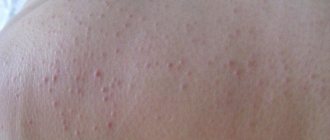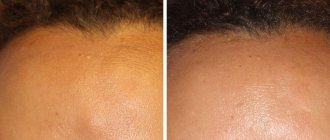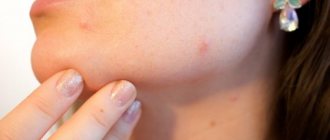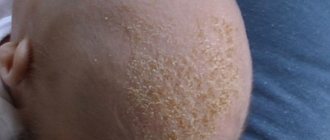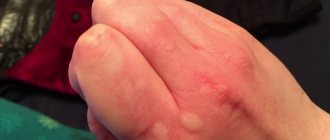Drinking alcoholic beverages can be accompanied not only by a severe hangover, but also by such an unpleasant phenomenon as skin rashes. Alcoholic urticaria can affect the skin of both the face and body, accompanied by itching, burning and discomfort.
The disease is not contagious and relates to the individual characteristics of the body.
- 4.1 Rashes on the face
What is alcoholic urticaria?
Alcoholic urticaria is an allergic disease accompanied by skin rash, itching and burning. The rash can affect the skin of the face, body, upper and lower extremities. Hives develop as a negative reaction of the body to an irritating substance - an allergen. An alcoholic drink or a certain component included in its composition acts as an allergen.
An allergic rash to alcohol consists of small spots and blisters that are red or pink in color. If left untreated, they begin to merge with each other, affecting large areas of the skin.
Allergic reaction
Alcoholic urticaria appears suddenly; rashes can appear after drinking several glasses of wine or after drinking a large amount of alcohol. This is one of the most common reactions of the body to drinking alcohol.
Despite the fact that the rash is non-contagious, it brings serious psychological and aesthetic discomfort to a person - especially if the rash affects the skin of the face. In such cases, qualified medical assistance is required.
Can there be an allergy to beer and how do symptoms manifest in adults (pictured)
In addition to dyes and flavor enhancers, which are present in almost every type of beer, allergies can also occur to certain natural components of this drink. The most common reasons are:
- Hop. This plant can cause allergic reactions
- Fungi that are found on yeast also cause unpleasant symptoms.
- Barley malt. This component can significantly increase beer allergies, since the drink uses sprouted malt.
Hereditary predisposition, beer abuse, increased tendency to diathesis, especially sensitization to cereal plants, and intolerance to gluten, which is a protein in cereals, increase the likelihood of developing allergies.
All these reasons, together and separately, can lead to the development of allergy symptoms, which require targeted and thorough treatment.
How does the pathological condition manifest?
Most often, an allergy to beer manifests itself in the form of Quincke's edema or urticaria.
Quincke's edema is characterized by the fact that immediately after drinking beer, intense swelling of the skin and subcutaneous fat develops. Symptoms appear quickly and progress rapidly. Swelling of the nose, lips and mouth occurs. With severe and sudden swelling of the tongue, suffocation may develop, followed by death, so treatment should be carried out immediately.
Symptoms of urticaria are characterized, as shown in the photo, by the appearance of red blisters, characterized by severe itching and rapid disappearance. The rash from an allergic reaction to beer goes away within two hours, but within 1-2 days new blisters may appear in a different location.
In addition to these symptoms, patients complain of the following manifestations:
- Allergic rhinitis and conjunctivitis. They are manifested by a feeling of nasal congestion and difficulty breathing, constant sneezing, and also, as shown in the photo, swelling, redness and itching of the eyelids.
- Possible development of bronchial asthma, characterized by shortness of breath with difficulty exhaling.
- Gastrointestinal allergic reaction. Symptoms of this condition include diarrhea associated with drinking fresh beer and abdominal pain.
Sometimes symptoms may occur that are not related to allergies. For example, nasal congestion and facial flushing may be due to the body's reaction to ethanol. These conditions do not require treatment.
What causes an allergy to beer?
Beer allergy photo.
So what causes an allergy to beer? As you know, an allergy is a personal intolerance by the body to a particular chemical compound that is part of a product.
The cause of the allergy is the presence of barley in it. Barley contains LPT protein, which, when barley grain is specially processed during beer production, causes allergies in people who are predisposed to this.
Another component of beer is hops, which can also cause an allergy to it in citizens who are especially susceptible to beer.
Yeast also causes allergies. For allergy sufferers, they, like the entire drink in general, can cause an increase in blood pressure, various skin rashes, heartburn, abdominal pain and nausea, sore throat or diarrhea.
Symptoms of a beer allergy
- swelling of the lips and tongue;
- tingling of the facial skin;
- unpleasant, pressing sensations;
- cough and dizziness.
Should you be treated for a beer allergy?
When the first strange rashes and strange phenomena appear in your body after drinking beer, you will need to make an appointment with an allergist.
Making a diagnosis on your own, and even more so, self-medicating, is strictly prohibited.
Firstly, it is almost impossible to correctly determine the causes of unpleasant symptoms on your own.
Secondly, self-administration of advertised anti-allergenic drugs can lead to much more serious consequences than the mild allergy itself.
Treatment of beer allergy with medications involves the use of various drops, ointments and other means that alleviate the patient’s condition. For example, the following ointments are used in treatment:
- Preparations containing panthenol (“Bipanten”, “D-panthenol”, “Pantoderm”).
- Retinol-containing medications (“Radevit”, “Videstim”).
- Antihistamine ointments (“Fenistil”, “Elidel”).
Of the tablets, the most common drug is Suprastin.
Traditional methods of treating beer allergies
Traditional treatment for beer allergies involves the use of drugs of plant and animal origin. Thus, one of the most effective remedies is mumiyo; it is also common to use an infusion of string, a decoction of dandelion and burdock roots, and blackcap powder.
In conclusion, it should be noted that, unfortunately, modern medicine is not able to fully determine the causes leading to beer allergy. Therefore, for allergy sufferers and beer lovers, the best solution would be to completely abstain from it. This is the only way to be guaranteed to get rid of allergies and not cause harm to your health.
What causes the reaction: reasons
The main composition of beer is yeast, malt, and hops. But they actively add to the basic components: herbs, dyes, flavor enhancers, preservatives, flavorings, etc. Therefore, there are hundreds of types of foamy drink on store shelves, differing in recipes and preparation details.
Allergy triggers are chemical and natural components. The human body reacts more adequately to malt hops, sourdough and barley malt. This is why intolerance to unfiltered “live” beer, which has a shelf life of only 1–7 days, is rare.
To reduce the cost of the product, the share of natural components is replaced with chemical analogues. This becomes the reason that the possibility of becoming allergic to cheap beer is higher than to its expensive types. Considering all of the above, you need to learn a few recommendations:
- Fewer additives – higher quality.
- The fresher the better. Pay attention to the shelf life and date of manufacture of the product.
- Beware of cross provocateurs. If you are allergic to wheat, avoid wheat beer.
- For the whole evening - only one type of product.
It has been noticed that people with hay fever (pollen intolerance) are prone to allergies to beer. It occurs in the spring, when a finger appears, and is manifested by itchy eyes and a constant runny nose.
What does an allergy look like?
Symptoms of beer allergy appear with varying degrees of severity. If it is mild, the symptomatic picture is erased, does not cause much inconvenience, and often goes unnoticed. The average degree is characterized by severe symptoms, with a large number of signs. The patient's condition improves immediately after starting treatment. In the symptomatic picture we observe:
- skin manifestations: itching, rash, the appearance of areas of redness and peeling;
- changes in the ENT organs and eyes: lacrimation, itching of the nasal mucosa, prolonged runny nose with thin, watery discharge;
- minor local reactions: swelling of the face, chin, upper and lower eyelids.
Rarely, severe allergies called anaphylactic shock occur. Symptoms appear and begin to worsen just a few minutes or seconds after drinking beer.
Blood pressure drops sharply, consciousness becomes confused, convulsions and involuntary urination appear. In the absence of fainting, the injured person complains of a feeling of heat, an overwhelming fear of death, and chest pain.
If this condition is accompanied by dysfunction of the cardiovascular and respiratory systems, death may occur.
Another manifestation of beer allergy is Quincke's edema (giant urticaria, angioedema). As a result of impaired vascular permeability, local swelling of various areas of the body - face, hands, tongue - occurs and increases at lightning speed. Local swelling of the palate, tonsils, and larynx is fraught with suffocation, even death.
Visual diagnosis of mild allergies to beer is difficult. Often a person has no idea why he has a slight cough, itchy skin, or runny nose. Moderate and severe reactions are visible from the above signs.
It is much more difficult to determine the allergen itself. For this purpose, special tests are carried out in the laboratory.
Such instrumental diagnostics with 100% results will identify the provocateur, which will avoid repeated attacks of the disease.
The best prevention of allergies to beer is the exclusion of allergens included in the composition from the diet!
Composition of beer and causes of allergies
It is worth noting that the composition of beer is not always identical and can vary significantly depending on the types and varieties of beer. But, nevertheless, the basic components for beer production are still the same.
Barley
A traditional component of beer is barley - a plant of the cereal family, which is also used in the food industry in the form of barley and pearl barley. To produce beer, it is not the grain itself that is used, but barley malt - the barley seedling.
Spikelet of barley
Instead of barley malt, beer producers can use other grains (for example, wheat beer is made with the addition of wheat malt). Beer can be made using other cereals:
- rice,
- rye,
- corn.
Beer may have a predominant component, and there are also hybrid varieties that use a combination of different cereal crops. Another option is special varieties, in the production of which non-traditional components are used, as well as various additives.
Source: https://my5card.ru/muzhskoe-zdorove/mozhet-li-byt-allergiya-na-pivo-i-kak-simptomy-proyavlyayutsya-u-vzroslyh-na-foto.html
Causes
Alcoholic urticaria can develop for several reasons. Most often, an allergic reaction is associated with congenital intolerance to alcohol, hypersensitivity to certain components of alcoholic beverages.
In some cases, skin rashes appear against the background of chronic diseases of the liver, kidneys and gastrointestinal tract, as well as when combining alcohol with medications.
Congenital alcohol intolerance
Urticaria from alcohol develops against the background of alcohol intolerance, which can be either congenital or acquired.
The congenital form is a genetically determined feature of the body in which it is not able to absorb and process ethyl alcohol and its breakdown products.
Allergic reaction to components of alcoholic beverages
Urticaria after alcohol is often acquired in nature - in such cases, the intolerance reaction is caused by the components that make up the alcoholic drink.
Most often, an allergic rash is caused by:
- preservatives (sulfites);
- dyes;
- flavorings;
- barley;
- hop;
- yeast;
- gluten;
- grape;
- wheat.
Attention! The largest amounts of these components are found in white, red wine and beer, so these alcoholic drinks most often cause allergic urticaria.
Alcohol or allergic itching - not the same thing?
It's not just after drinking that your feet itch. The symptom may occur due to an allergic reaction. Therefore, before taking any action, it is necessary to understand the cause of the disease.
There are several differences between allergies and alcohol poisoning:
- Allergic itching is usually clearly localized on the body. It may itch your arm, neck, shoulder or back. For liver problems, alcohol causes itchy sensations throughout the body.
- Allergy symptoms are relieved with antihistamines. If there are liver abnormalities, it will take longer to resolve the problem.
- If a disease of the body's natural filter develops, additional symptoms occur. Vomiting, nausea and jaundice may occur.
It should be noted that self-medication can be dangerous. An incorrect diagnosis can cause serious complications. Therefore, if skin problems arise, it is better to trust a specialist.
A qualified doctor will be able to objectively assess the clinical picture. To do this, the patient will need to undergo prescribed tests. Once the diagnosis is made, the doctor will be able to decide on a therapeutic strategy.
Symptoms of alcoholic urticaria
Urticaria from alcohol is accompanied not only by skin rashes, but by other characteristic symptoms.
Quincke's edema
- swelling, itching and burning of the skin;
- a sharp increase or decrease in body temperature;
- changes in blood pressure;
- stool disorder;
- nausea accompanied by vomiting;
- runny nose, lacrimation;
- weakness, malaise, loss of strength.
One of the most dangerous symptoms of an alcohol allergy is difficulty breathing. Lack of air poses a serious danger to human life; Quincke's edema may appear - a complication accompanied by swelling of the larynx, oral mucosa, and suffocation.
Characteristic features of the rash
Under certain conditions, rashes characteristic of alcoholic urticaria can form small tumors into swelling, the size of which will be comparable to the palm of an adult. Such complications often result from scratching, as well as neglecting the recommendations of specialists. Most often, the color of rashes and pimples during the development of urticaria has a porcelain-white tint, which turns into a red or light pink color. The advanced form of the disease is characterized by pale bluish blisters, the fight against which is very difficult. Considering the characteristics of the disease, as well as the attitude of people of this social group to their health, many people suffering from this type of urticaria prefer to ignore the symptoms and not seek help from specialists. In this case, an extensive type of urticaria can cause damage to:
- buccal mucous membranes;
- pharynx;
- larynx;
- as well as language.
This type of disease can provoke attacks of difficulty breathing and swallowing, which carries a potentially serious danger to human life. Chronic forms of alcoholic urticaria provoke a gradual appearance of rashes, and the period of appearance itself can last from several hours to several days. Thanks to timely seeking medical help from specialists, the treatment period for the disease can be reduced from several months to a couple of weeks.
Difficulty swallowing is common in alcoholic urticaria
Localization of alcohol rash
The rash after alcohol can have different localizations, affecting the skin of the face, upper and lower extremities, as well as the entire body. Regardless of the specific location, a feature of alcoholic urticaria is considered to be very rapid spread - in just a few minutes or hours, the rash can cover almost the entire body.
Rashes on the face
Rashes on the face after alcohol most often appear instantly, immediately after drinking an alcoholic drink. Many people perceive a sharp reddening of the cheeks as a normal blush.
In this case, a rash on the face can also affect the skin of the neck and décolleté, accompanied by itching and discomfort, and the appearance of blisters filled with a cloudy liquid. If a person stops further drinking alcohol, after a short time the redness disappears and the skin restores its original appearance.
Rash on the body
Alcohol rash often affects the body - most often the skin of the neck, chest and abdomen. Hives begin with the appearance of small red dots, which quickly merge with each other and increase in size. In the most severe cases, large watery blisters appear at the site of the rash, which cause severe burning of the skin.
Treatment
Treatment of alcoholic urticaria is aimed at eliminating the symptoms of the disease and preventing its recurrence.
Complete abstinence from alcohol
First of all, with urticaria, alcohol is completely excluded, since in case of heavy drinking, it will become impossible to cure the disease. After this, adsorbent preparations are used that remove allergen substances from the body.
- Enterosgel;
- Polysorb;
- Activated carbon.
A person with alcoholic urticaria is prescribed antihistamines - Zyrtec, Eden, Telfast, Erius. The course of treatment usually lasts 7-10 days. New generation medications are highly effective and do not have a sedative effect on the nervous system.
To eliminate skin rashes, burning and itching, you can use ointments to treat the affected areas - Akriderm, Advantan. In the most severe cases, hormonal drugs are used - Hydrocortisone, Dexamethasone, Prednisolone.
A mandatory part of the treatment of alcoholic urticaria is diet. You need to exclude from your diet not only any alcoholic drinks, but also all foods that can trigger food allergies - chocolate, honey, citrus fruits, seafood, eggs.
Only a specialist will be able to identify the specific allergen that causes hives. There is a high probability that after this you will not have to give up alcohol completely in the future, limiting yourself to excluding some type of drinks.

